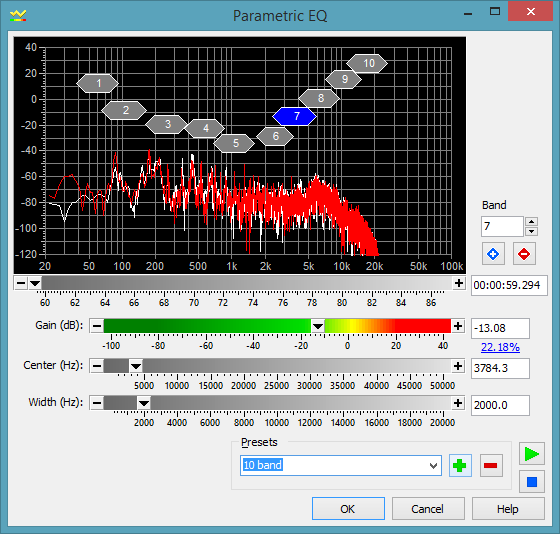
A parametric equalizer (shown below) is a flexible tool for reducing or enhancing ranges of frequencies. GoldWave presents an easy to use interface where all the parameters for up to 40 bands can be configured quickly. Presets contain some commonly used templates.

Graph window
The graph shows frequency on the x-axis in Hertz and the
gain on the y-axis in decibels. Each enabled band is
displayed in the graph as a diamond shaped box located at
its center frequency and gain. The width of the box shows
the bandwidth. The currently selected band is shown in
blue and its exact settings are given in edit box controls.
A short time frequency analysis graph is drawn with the left channel in green and the right channel in red. The time of the analysis can be changed using the scroll bar located at the bottom of the graph. The analysis helps determine what frequencies to boost or reduce. A high pitched squeal, for example, would appear as a spike near the right side of the graph. Whereas a low pitched hum would be a spike or bump near the left side.
Controls
A band is configured by selecting its number from the
Band box and adjusting the Gain, Width, and Center faders. A quicker
method is to drag-and-drop the band to a new location on the
graph. Note that because of the logarithmic frequency
scale, the width of a diamond changes as you move it left
or right. The bandwidth, however, remains constant.
Use the diamond plus button to add more bands. Use the diamond minus button remove existing bands. The current (blue) band given in the Band box is the one removed.
The "Notch" preset is effective for removing a simple tone from a sound, such as a 60Hz hum or telephone dial tones. The "Bass boost" and "Treble boost" presets work the same way as the bass and treble controls on a stereo system. Adjust the gain up or down to control them.
See Also: Equalizer, Noise Reduction, Spectrum Filter, Presets